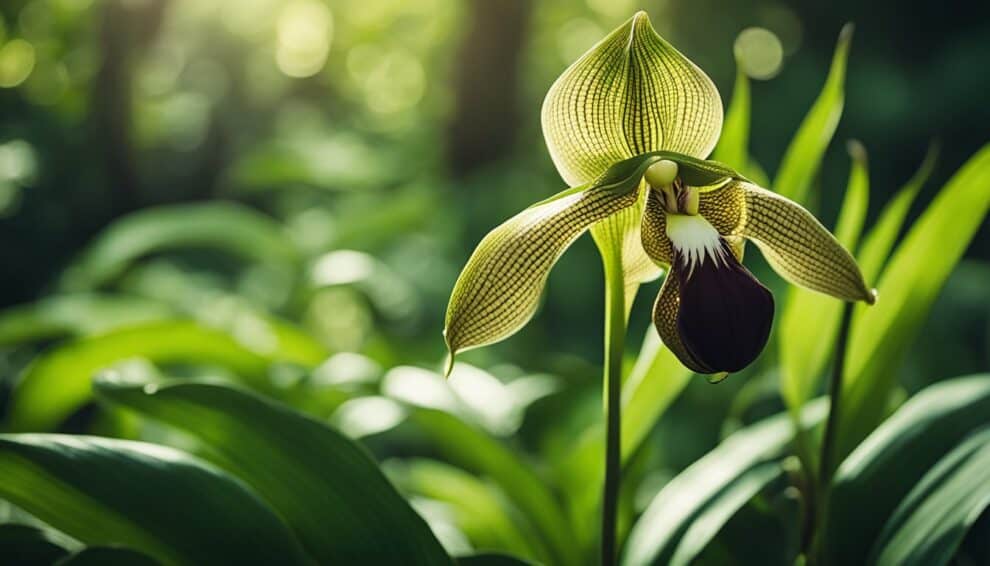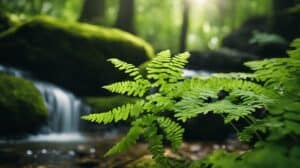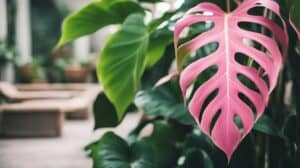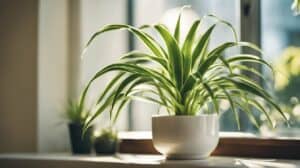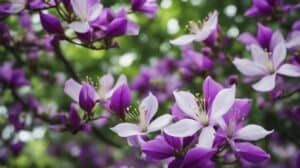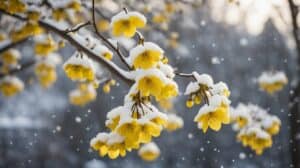The Lady Slipper Orchid, also known as Paphiopedilum, is a genus of orchids that is native to Southeast Asia.
It is known for its unique slipper-shaped lip, which is used to trap insects for pollination.
The Lady Slipper Orchid is a popular choice among orchid enthusiasts due to its exquisite beauty and unusual shape.

The Paphiopedilum orchid is a fascinating plant that has captured the attention of many people around the world.
Its unique slipper-shaped lip is not only visually striking, but also serves an important function in the plant’s reproduction.
The Lady Slipper Orchid is a slow-growing plant that requires specific growing conditions, making it a challenging but rewarding addition to any orchid collection.
Overall, the Lady Slipper Orchid is a curious and captivating plant that continues to intrigue and inspire people with its beauty and complexity.
Understanding Paphiopedilum
Taxonomy and Classification
Paphiopedilum, commonly known as Lady Slipper Orchids, is a genus of the family Orchidaceae.
The genus comprises around 80 species, which are mainly found in Southeast Asia, the Indian Subcontinent, and the Pacific Islands.
The name Paphiopedilum is derived from the Greek words “Paphos” (a city in Cyprus) and “pedilon” (a slipper), which refers to the shape of the lip of the flower.
The taxonomy and classification of Paphiopedilum have undergone several revisions over the years.
Initially, all Lady Slipper Orchids were classified under the genus Cypripedium.
However, in 1864, Paphiopedilum was recognized as a distinct genus by the British botanist John Lindley.
Since then, the taxonomy of Paphiopedilum has been revised several times based on morphological and molecular data.
Distinctive Features
Lady Slipper Orchids are known for their unique and distinctive features.
They have a sympodial growth habit, which means that the new growth arises from the base of the previous growth.
The leaves are usually leathery and dark green, arranged in a rosette at the base of the plant.
The flowers are borne on a long stalk and have a pouch-like lip, which resembles a slipper.
The slipper is often brightly colored and patterned, while the sepals and petals are usually green or brown.
One of the most distinctive features of Lady Slipper Orchids is their pollination mechanism.
Unlike other orchids, which rely on insects for pollination, Lady Slipper Orchids are self-pollinating.
The slipper-like lip of the flower acts as a trap for insects, which are forced to crawl out through a narrow exit.
As they do so, they come into contact with the stigma and pollinate the flower.
In conclusion, Lady Slipper Orchids are a fascinating genus of orchids with unique and distinctive features.
Their taxonomy and classification have undergone several revisions, and they are known for their self-pollinating mechanism.
Cultivation and Care
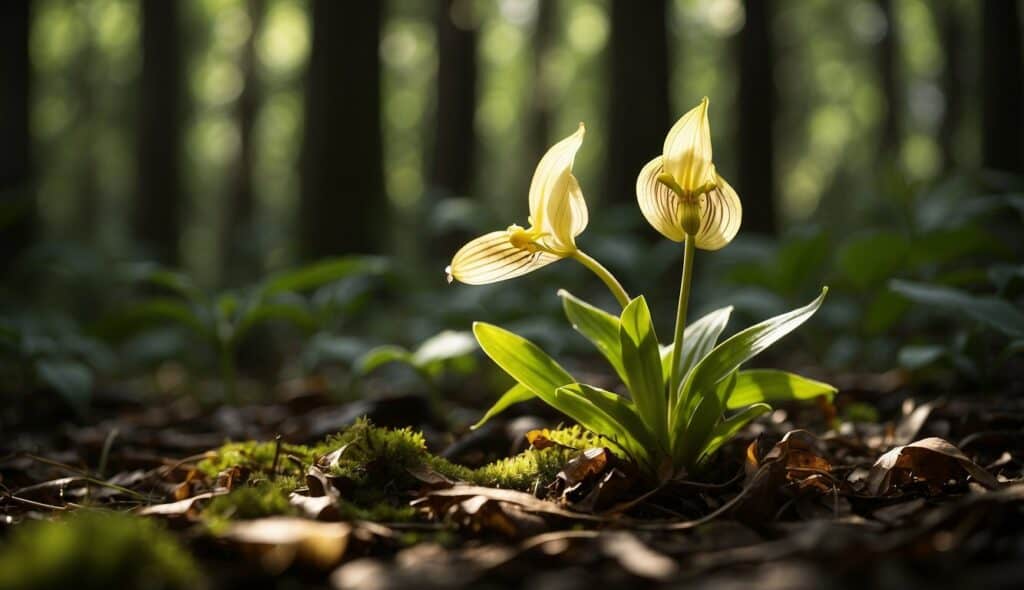
Light and Temperature Requirements
Lady Slipper Orchids prefer a bright, indirect light source. Direct sunlight can scorch the leaves and cause damage to the plant.
They thrive in temperatures between 65-80°F during the day and 50-60°F at night.
Avoid placing the plant near drafts or heating/cooling vents as it can cause stress to the plant.
Watering and Feeding
When it comes to watering, Lady Slipper Orchids require a consistent watering schedule. They prefer to be kept moist but not waterlogged.
Water the plant when the top inch of soil feels dry to the touch. It is recommended to use distilled or rainwater to avoid mineral buildup in the soil.
Fertilize the plant every two weeks during the growing season using a balanced orchid fertilizer.
Repotting and Substrate
Lady Slipper Orchids should be repotted every two to three years. Use a well-draining orchid mix consisting of bark, sphagnum moss, and perlite.
When repotting, be gentle with the roots as they are delicate. It is recommended to repot after the blooming season has ended.
Overall, Lady Slipper Orchids are relatively easy to care for as long as their basic needs are met.
With the right conditions, they can be a stunning addition to any home or garden.
Propagation and Hybridization

Asexual Reproduction Methods
Lady Slipper Orchids can be propagated through several asexual reproduction methods, including division and meristem culture.
Division involves separating the plant into smaller sections, each with a portion of the root system.
This method is best done during the spring when new growth is starting to emerge.
Meristem culture involves taking a small section of tissue from the plant and growing it in a sterile environment to produce a new plant.
This method is more difficult and requires specialized equipment and knowledge.
Hybrid Varieties and Breeding
Lady Slipper Orchids have been hybridized extensively to create a wide variety of colors, patterns, and shapes.
Hybridization involves crossing two different species or varieties to create a new plant with desirable traits.
Breeders carefully select the parent plants based on their characteristics and then use techniques such as hand pollination to control the breeding process.
Some popular hybrid varieties include Paphiopedilum Maudiae, Paphiopedilum Pinocchio, and Paphiopedilum Rothschildianum.
Breeding Lady Slipper Orchids can be a challenging and time-consuming process.
It can take several years to produce a new hybrid variety that meets the breeder’s standards.
However, the results can be stunning and well worth the effort.
With careful selection and breeding, it is possible to create Lady Slipper Orchids with unique colors, patterns, and shapes that are not found in nature.
Overall, propagation and hybridization are important aspects of Lady Slipper Orchid cultivation.
By using a variety of asexual reproduction methods and carefully selecting parent plants for breeding, growers can produce new plants with desirable traits and create stunning hybrid varieties that are sure to impress.
Conservation and Challenges

Habitat Preservation
Lady Slipper Orchids, also known as Paphiopedilum, are a rare and delicate species that require specific environmental conditions to thrive.
These orchids are primarily found in the wild in tropical and subtropical regions of Asia.
Due to deforestation and habitat destruction, the natural habitats of these orchids are rapidly diminishing.
Conservation efforts are being made to preserve the natural habitats of Lady Slipper Orchids.
Protected areas have been established, and reforestation projects are underway to restore degraded habitats.
Additionally, some orchid enthusiasts are growing these orchids in greenhouses to prevent further destruction of their natural habitats.
Threats and Protection Efforts
The popularity of Lady Slipper Orchids in the horticultural trade has led to over-harvesting, which has contributed to the decline of wild populations.
The illegal collection of these orchids from the wild is a major threat to their survival.
To protect these orchids, many countries have implemented laws and regulations that prohibit the collection and trade of wild orchids.
The Convention on International Trade in Endangered Species of Wild Fauna and Flora (CITES) also regulates the international trade of Lady Slipper Orchids.
Despite these efforts, the illegal trade of Lady Slipper Orchids remains a significant challenge.
It is essential to continue to raise awareness about the importance of protecting these orchids and their habitats to ensure their survival for future generations.
Frequently Asked Questions
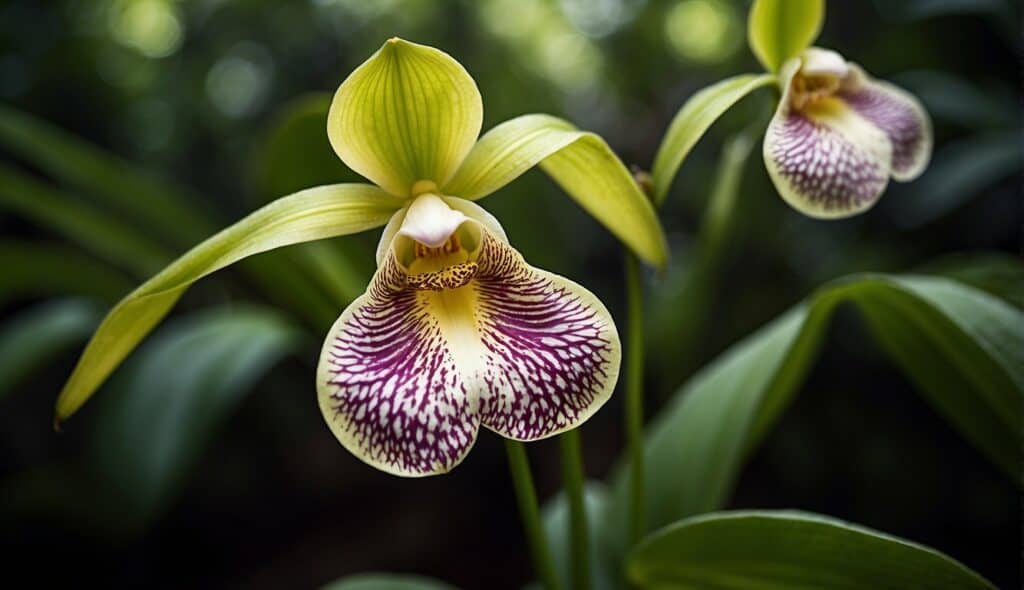
What are the ideal growing conditions for a Lady Slipper Orchid?
Lady Slipper Orchids thrive in warm, humid environments with indirect sunlight.
They prefer temperatures between 60-85°F (15-29°C) and humidity levels around 50-70%.
These orchids also require well-draining soil and good air circulation.
How often should I water my Paphiopedilum orchid?
Lady Slipper Orchids should be watered when the top layer of soil is dry to the touch.
This usually occurs every 7-10 days, but may vary depending on the environment.
It’s important not to overwater these orchids, as they are susceptible to root rot.
Can you provide tips for repotting a Lady Slipper Orchid?
Lady Slipper Orchids should be repotted every 1-2 years, or when the potting mix has broken down and become compacted.
When repotting, it’s important to use a well-draining orchid mix and to avoid damaging the roots.
It’s also recommended to repot in the spring or summer when the orchid is actively growing.
What are common pests and diseases that affect Lady Slipper Orchids, and how can I treat them?
Common pests that affect Lady Slipper Orchids include spider mites, mealybugs, and scale insects. These can be treated with insecticidal soap or neem oil.
Diseases that affect these orchids include root rot and fungal infections, which can be prevented by ensuring proper watering and good air circulation.
How can I encourage my Lady Slipper Orchid to bloom?
Lady Slipper Orchids require a period of cool temperatures (around 55-65°F or 13-18°C) in order to initiate blooming.
This can be achieved by placing the orchid in a cooler room or by providing a temperature drop at night.
It’s also important to ensure the orchid is receiving adequate light and nutrients.
Is it normal for the leaves of my Paphiopedilum to turn yellow, and what should I do if they do?
Yellowing leaves on a Lady Slipper Orchid can be a sign of overwatering, underwatering, or nutrient deficiencies.
It’s important to identify the cause of the yellowing and adjust watering and fertilization accordingly.
In some cases, yellow leaves may also be a sign of pest or disease problems.






